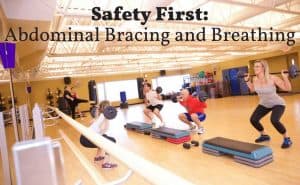
Safety is the #1 priority when it comes to weight training. Having poor lifting form can result in back pain or severe injuries to your spine. Using abdominal bracing and breathing techniques will give you proper posture and stabilize your back while lifting.
Abdominal Bracing
Contracting every abdominal muscle, from the deepest to the most superficial, to promote spinal stability and efficient biomechanics is what is coined as “abdominal bracing.” Almost any coach or trainer uses the example of tensing the core as if you were about to get jabbed in the stomach. In addition to tensing the core, this pretend scenario also gets you to push out with your stomach as if you were about to expel an object.
Mastering the brace will not only be most effective for relieving back pain, but it will also teach your abdominals how to contract in unison most efficiently, which translates into increased core strength and abdominal development (2). Don’t believe us? Try it for yourself. Perform a goblet squat with a weight that you would perceive as very heavy while doing each of the following individually: 1) zero voluntary contraction of the abs, besides their normal involvement in the movement 2) abs are tensed and the belly is sucked in 3) abs are tensed and the belly is pushed out. You should notice a difference as you progress in scenarios with your ability to maintain an upright posture. In general, the more abdominal muscles activated, the greater the support for your spine and the more efficient you will be at performing an exercise.
Neutral Spine
Bracing is just one of the things that must happen in order to increase spinal safety. However, sometimes bracing is not enough to maintain proper spinal alignment. This is especially true in certain exercises where the back musculature has a greater role in the movement, such as in the deadlift and all of its variations (Romanian deadlift (RDL), kettlebell swing, etc).
The RDL is the most basic of the deadlifts and is easily butchered, due to lack of kinesthetic awareness (not knowing what it feels like to properly perform a movement) and lack of strength (inability to maintain form throughout the movement). Lack of strength usually is not the limiting factor when a beginner attempts this exercise, since the weight is kept relatively light. Novice individuals have a tendency to round the back when first attempting this movement. The vertebral discs are not a huge fan of being put into that position. When heavier loads are introduced, the possibility of one of your discs bursting out of your back increases. Practice getting into this position before increasing weight.

Other common errors
Make sure your chin remains tucked. I know it is tempting to watch yourself in the mirror, but cranking your head back to see yourself will promote hyperextension of the spine, which also is no bueno.
The Valsalva Maneuver
Air matters! Really, technically, air is matter. Matter is anything that has mass and takes up space. Today, we do not care that air has mass. We do, however, care that air takes up space. When you inhale, your lungs fill with air. When you brace your abs while your lungs are still full, pressure within you increases (this is called intra-abdominal pressure). This pressure reinforces your core. Research confirms this, too (2). Remember, core strength is vital for spinal protection.
Here’s how with the squat
- inhale
- brace
- squat down
- stand up and begin to exhale halfway through or wait until the motion is completed
- un-brace
- repeat
*Note: Although this method cushions your spine, it may also elevate blood pressure to a greater extent than regular breathing patterns during exercise would (3). If you are someone that needs to watch your blood pressure’s response to exercise, play it safe, do not use this breathing protocol. That said, if blood pressure is a major concern to begin with, you should have medical clearance from your physician and be exercising under the supervision of a qualified professional anyways.*
All trainers at Elite know how to teach a neutral spine with abdominal bracing and proper breathing patterns. Do not hesitate to reach out to any one of them!
Set up a Free Fitness ConsultationReferences:
1) Koh, H-W, Cho, S-H, and Kim,C-Y. Comparison of the effects of hollowing and bracing exercises on cross-sectional areas of abdominal muscles in middle-aged women. Journal of Physical Therapy Science. 26(2): 295–299, 2014.
2) Hodges, P, Eriksson, A, Shirley, D, and Gandevia, S. Intra-abdominal pressure increases stiffness of the lumbar spine. J Biomech. 38(9): 1873-80, 2005.
3) Chow, C, and Hackett, D. The Valsalva maneuver: its effect on intra-abdominal pressure and safety issues during resistance exercise. J Strength Cond Res. 27(8): 2338-45, 2013.